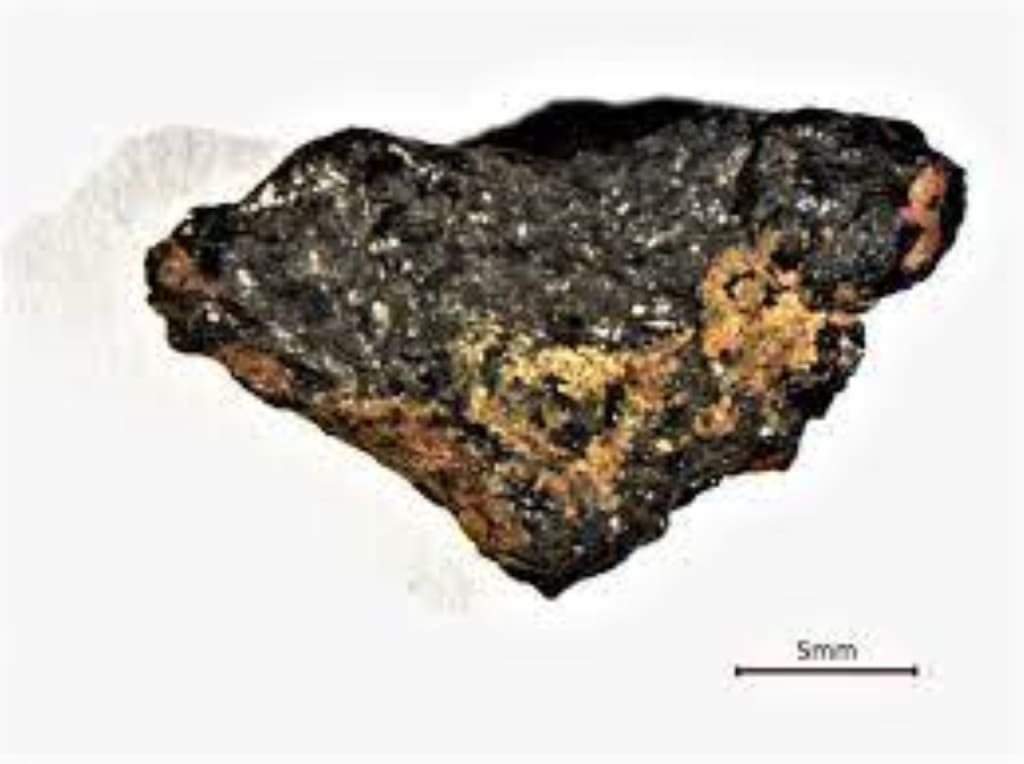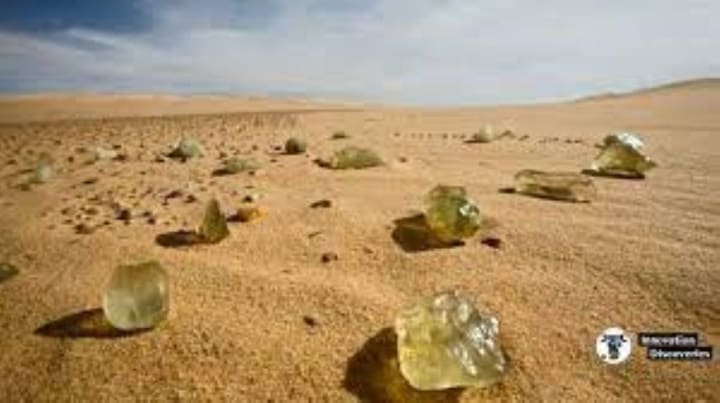The mysterious rock in solar system
Hypatia is the rock that has secret

In the vast and mysterious Great Sand Sea of Egypt, there lies a mind-boggling expanse of yellow glass that has scientists scratching their heads. This otherworldly glass field, believed to have extraterrestrial origins, is a hotbed of scientific intrigue. But that's not all – nestled amidst this enigmatic glass, researchers stumbled upon stones containing diamonds that defy everything we thought we knew about our solar system. Talk about shaking things up!
Back in 1996, Dr. Aly A. Barakat embarked on an expedition to the Libyan Desert Glass Strewn Field, a sprawling 2,500 square mile region covered in peculiar yellow glass. This glass bears a striking resemblance to Trinitite, the aftermath of the first atomic bomb blast known as "Operation Trinity" in the New Mexico desert. Ancient Egyptians clearly had a thing for this glass, as it adorned the jewelry of pharaohs, including Tutankhamun himself.
During Barakat's expedition, a few seemingly unremarkable stones caught his attention amidst the yellow glass. These stones were later named after Hypatia, a brilliant astronomer and mathematician from ancient Alexandria. Fast forward to 2013, and after analyzing the noble gas and nitrogen isotopes, scientists made a groundbreaking announcement – these Hypatia stones were indeed extraterrestrial in origin. But here's the real kicker: they were unlike anything we've ever seen before.
These stones were almost pure carbon with minuscule amounts of silica, which is the complete opposite of what we find in other meteorites or comet fragments. And their nitrogen isotope ratios were out of this world, quite literally. It seems these stones formed before their mysterious cosmic journey brought them crashing into our atmosphere.
Lead researcher Jan Kramers humorously likened the Hypatia pebble to a poorly mixed fruit cake, with various mineral grains acting as glace cherries and nuts. Meanwhile, the cracks in the fallen cake were filled with "secondary materials" from Earth, creating a mind-boggling mix. But that's not all – these stones contained rare components that left scientists in awe. Pure metallic aluminum, which is a rarity on Earth, was found alongside an unprecedented alloy of phosphorus and nickel, devoid of any iron. It's safe to say we were definitely not expecting that!
But the surprises didn't end there. The Hypatia stones also contained a significant amount of polyaromatic hydrocarbons (PAH), which are carbon compounds commonly found in interstellar dust. These compounds predate the formation of our solar system. Kramers believes this indicates that Hypatia formed in an ultra-cold environment, potentially far beyond the asteroid belt or even the Kuiper Belt. It's like a space mystery wrapped in a riddle!
So where did Hypatia come from? The South African professor admits that we have a lot to learn about the chemical compositions of objects lurking in the far reaches of our solar system. But one thing's for sure – Hypatia's origin story is far more fascinating than we could have ever imagined.
Now, picture this: what if Hypatia exploded with the force of an atomic bomb, scattering tiny remnants of itself across the desert as cryptic clues for future researchers? It's a thrilling possibility, but there's just one problem – where's the crater? Well, it seems that the prime suspect for the explosive event that birthed all this nuclear glass is a whopping 19-mile diameter crater called the Kebira Crater. The catch? It's so remote that it's practically invisible from the ground. Thankfully, Egyptian space scientist Farouk El-Baz and geomorphologist Eman Goneim stumbled upon evidence of this colossal crater in 2007 while analyzing satellite data. But due to itsIn the vast and mysterious Great Sand Sea of Egypt, there lies a mind-boggling expanse of yellow glass that has scientists scratching their heads. This otherworldly glass field, believed to have extraterrestrial origins, is a hotbed of scientific intrigue. But that's not all – nestled amidst this enigmatic glass, researchers stumbled upon stones containing diamonds that defy everything we thought we knew about our solar system. Talk about shaking things up!
Back in 1996, Dr. Aly A. Barakat embarked on an expedition to the Libyan Desert Glass Strewn Field, a sprawling 2,500 square mile region covered in peculiar yellow glass. This glass bears a striking resemblance to Trinitite, the aftermath of the first atomic bomb blast known as "Operation Trinity" in the New Mexico desert. Ancient Egyptians clearly had a thing for this glass, as it adorned the jewelry of pharaohs, including Tutankhamun himself.
During Barakat's expedition, a few seemingly unremarkable stones caught his attention amidst the yellow glass. These stones were later named after Hypatia, a brilliant astronomer and mathematician from ancient Alexandria. Fast forward to 2013, and after analyzing the noble gas and nitrogen isotopes, scientists made a groundbreaking announcement – these Hypatia stones were indeed extraterrestrial in origin. But here's the real kicker: they were unlike anything we've ever seen before.
These stones were almost pure carbon with minuscule amounts of silica, which is the complete opposite of what we find in other meteorites or comet fragments. And their nitrogen isotope ratios were out of this world, quite literally. It seems these stones formed before their mysterious cosmic journey brought them crashing into our atmosphere.
Lead researcher Jan Kramers humorously likened the Hypatia pebble to a poorly mixed fruit cake, with various mineral grains acting as glace cherries and nuts. Meanwhile, the cracks in the fallen cake were filled with "secondary materials" from Earth, creating a mind-boggling mix. But that's not all – these stones contained rare components that left scientists in awe. Pure metallic aluminum, which is a rarity on Earth, was found alongside an unprecedented alloy of phosphorus and nickel, devoid of any iron. It's safe to say we were definitely not expecting that!
But the surprises didn't end there. The Hypatia stones also contained a significant amount of polyaromatic hydrocarbons (PAH), which are carbon compounds commonly found in interstellar dust. These compounds predate the formation of our solar system. Kramers believes this indicates that Hypatia formed in an ultra-cold environment, potentially far beyond the asteroid belt or even the Kuiper Belt. It's like a space mystery wrapped in a riddle!
So where did Hypatia come from? The South African professor admits that we have a lot to learn about the chemical compositions of objects lurking in the far reaches of our solar system. But one thing's for sure – Hypatia's origin story is far more fascinating than we could have ever imagined.
Now, picture this: what if Hypatia exploded with the force of an atomic bomb, scattering tiny remnants of itself across the desert as cryptic clues for future researchers? It's a thrilling possibility, but there's just one problem – where's the crater? Well, it seems that the prime suspect for the explosive event that birthed all this nuclear glass is a whopping 19-mile diameter crater called the Kebira Crater. The catch? It's so remote that it's practically invisible from the ground. Thankfully, Egyptian space scientist Farouk El-Baz and geomorphologist Eman Goneim stumbled upon evidence of this colossal crater in 2007 while analyzing satellite data. But due to its

During Barakat's exploration, seemingly unremarkable stones caught his attention amidst the yellow glass. These stones were later named after Hypatia, an eminent female astronomer and mathematician from ancient Alexandria. It wasn't until 2013, after analyzing noble gas and nitrogen isotopes, that researchers made a startling announcement – the Hypatia stones were of extraterrestrial origin. Even more astonishing, these stones defied the conventional characteristics of meteorites or comet fragments. They consisted mostly of pure carbon with minimal silica, exhibiting nitrogen isotope ratios distinct from anything found on Earth. These unusual features suggested that the stones were formed before their mysterious journey brought them crashing into our atmosphere.
Lead researcher Jan Kramers playfully compared the composition of the Hypatia stones to a poorly mixed fruit cake, with mineral grains resembling glace cherries and nuts, while the fractures within the stone contained "secondary materials" from Earth. But the surprises didn't end there. These stones contained rare components, including pure metallic aluminum, which is exceptionally scarce on Earth, as well as an unprecedented alloy of phosphorus and nickel devoid of iron. Additionally, they held a significant amount of polyaromatic hydrocarbons (PAH), carbon compounds typically found in interstellar dust predating the formation of our solar system. These revelations indicated that Hypatia had likely formed in an extremely cold environment, far beyond the reaches of the asteroid belt or even the Kuiper Belt.
The question of Hypatia's origin lingers, highlighting our limited understanding of the chemical compositions of celestial objects in the distant corners of our solar system. The tantalizing notion emerges that Hypatia might have exploded with atomic bomb-like force, scattering fragments as cryptic remnants across the desert. However, the elusive crater associated with such an event, the potential birthplace of the nuclear glass, remains a challenge to locate. Thanks to the efforts of Egyptian space scientist Farouk El-Baz and geomorphologist Eman Goneim, satellite data analysis in 2007 led to the discovery of a colossal 19-mile diameter crater named the Kebira Crater, a plausible candidate for the explosive event that birthed the desert glass and Hypatia stone fragments. However, due to its remote location, further investigation has been limited.
The captivating saga of the Great Sand Sea's yellow glass and Hypatia stones continues to fascinate, enveloped in cosmic mysteries and the potential for groundbreaking revelations. The enigmatic pieces of this celestial puzzle beckon intrepid scientists to unlock the secrets they hold, reminding us that the universe is an endless source of wonder and discovery
About the Creator
Enjoyed the story? Support the Creator.
Subscribe for free to receive all their stories in your feed. You could also pledge your support or give them a one-off tip, letting them know you appreciate their work.





Comments
There are no comments for this story
Be the first to respond and start the conversation.